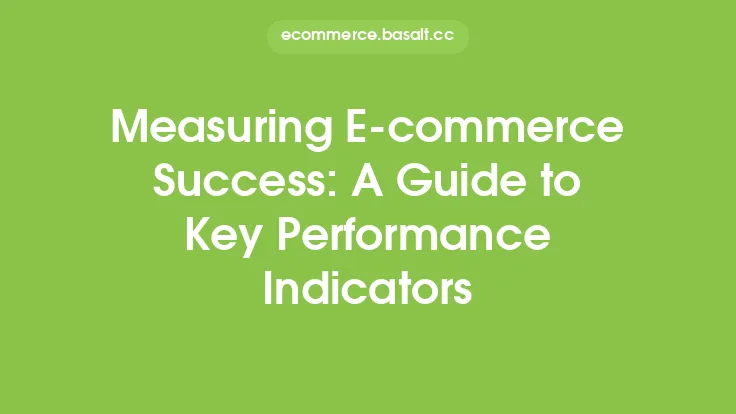In the world of e-commerce, measuring performance is crucial to understanding the success of an online business. With the vast amount of data available, it can be overwhelming to determine which metrics are most important. Key Performance Indicators (KPIs) are the solution to this problem, providing a clear and concise way to evaluate the health and success of an e-commerce business. In this article, we will explore the most important KPIs for e-commerce businesses, and how they can be used to drive growth and improvement.
Introduction to E-commerce KPIs
E-commerce KPIs are metrics that measure specific aspects of an online business, such as sales, customer behavior, and website performance. These metrics provide insights into the strengths and weaknesses of an e-commerce business, allowing owners and managers to make informed decisions about strategy and resource allocation. By tracking and analyzing KPIs, e-commerce businesses can identify areas for improvement, optimize their operations, and ultimately drive more sales and revenue.
Sales and Revenue KPIs
Sales and revenue are the lifeblood of any e-commerce business, and there are several KPIs that measure these metrics. Some of the most important sales and revenue KPIs include:
- Conversion rate: The percentage of website visitors who make a purchase.
- Average order value (AOV): The average amount spent by customers in a single transaction.
- Sales growth rate: The rate at which sales are increasing or decreasing over time.
- Revenue per user (RPU): The average amount of revenue generated per user or customer.
- Gross margin: The difference between revenue and the cost of goods sold, expressed as a percentage.
Customer KPIs
Customer KPIs measure the behavior and loyalty of an e-commerce business's customer base. Some of the most important customer KPIs include:
- Customer acquisition cost (CAC): The cost of acquiring a new customer, including marketing and advertising expenses.
- Customer lifetime value (CLV): The total amount of revenue generated by a customer over their lifetime.
- Customer retention rate: The percentage of customers who return to make repeat purchases.
- Customer satisfaction (CSAT): A measure of how satisfied customers are with their experience, typically measured through surveys or reviews.
- Net promoter score (NPS): A measure of customer loyalty, based on the likelihood of customers to recommend the business to others.
Marketing and Advertising KPIs
Marketing and advertising KPIs measure the effectiveness of an e-commerce business's marketing efforts. Some of the most important marketing and advertising KPIs include:
- Return on ad spend (ROAS): The revenue generated by an advertising campaign, compared to its cost.
- Cost per acquisition (CPA): The cost of acquiring a new customer through advertising or marketing efforts.
- Click-through rate (CTR): The percentage of users who click on an ad or link after seeing it.
- Conversion rate by channel: The percentage of users who make a purchase after coming from a specific marketing channel, such as social media or email.
- Email open rate: The percentage of email recipients who open an email campaign.
Operational and Logistics KPIs
Operational and logistics KPIs measure the efficiency and effectiveness of an e-commerce business's operations, including order fulfillment, shipping, and customer service. Some of the most important operational and logistics KPIs include:
- Order fulfillment rate: The percentage of orders that are fulfilled correctly and on time.
- Shipping cost as a percentage of sales: The cost of shipping, compared to total sales revenue.
- Inventory turnover: The number of times inventory is sold and replaced within a given period.
- Customer service response time: The time it takes for customer service representatives to respond to customer inquiries.
- Return rate: The percentage of orders that are returned, and the reasons for returns.
Website Performance KPIs
Website performance KPIs measure the speed, usability, and overall performance of an e-commerce website. Some of the most important website performance KPIs include:
- Page load time: The time it takes for web pages to load, which can impact user experience and conversion rates.
- Bounce rate: The percentage of users who leave a website without taking any further action.
- Average session duration: The amount of time users spend on a website during a single session.
- Mobile conversion rate: The percentage of mobile users who make a purchase, compared to desktop users.
- Website uptime: The percentage of time that a website is available and accessible to users.
Using KPIs to Drive Growth and Improvement
KPIs are only useful if they are used to drive growth and improvement in an e-commerce business. By tracking and analyzing KPIs, businesses can identify areas for improvement, optimize their operations, and make data-driven decisions about strategy and resource allocation. Some ways to use KPIs to drive growth and improvement include:
- Setting targets and goals for KPIs, and tracking progress over time.
- Analyzing KPIs to identify trends and patterns, and making adjustments to strategy and operations accordingly.
- Using KPIs to evaluate the effectiveness of marketing campaigns and advertising spend.
- Identifying areas for improvement in customer service, order fulfillment, and shipping, and making changes to optimize these processes.
- Using KPIs to measure the impact of new initiatives and strategies, and making adjustments as needed.
Best Practices for Tracking and Analyzing KPIs
To get the most out of KPIs, e-commerce businesses should follow best practices for tracking and analyzing these metrics. Some best practices include:
- Setting clear and specific goals for KPIs, and tracking progress over time.
- Using a variety of data sources, including website analytics, customer feedback, and financial reports.
- Analyzing KPIs regularly, and making adjustments to strategy and operations accordingly.
- Using data visualization tools to present KPIs in a clear and concise manner.
- Sharing KPIs with stakeholders, including employees, investors, and customers, to ensure everyone is aligned and working towards the same goals.
Conclusion
Key Performance Indicators (KPIs) are a crucial tool for e-commerce businesses, providing insights into sales, customer behavior, website performance, and operational efficiency. By tracking and analyzing KPIs, businesses can identify areas for improvement, optimize their operations, and drive growth and revenue. Whether you're just starting out or looking to take your e-commerce business to the next level, understanding and using KPIs is essential for success in the competitive world of online retail.





